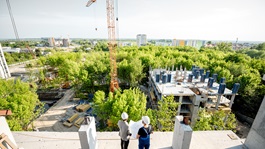This article first appeared in Construction News on September 8, 2016
A draft of the new Electronic Communications Code has been published – but does it solve the issues posed by the existing code?
Even for those who use the existing Electronic Communications Code regularly, it can seem complicated, difficult to interpret and short of effective solutions to issues faced by landowners and operators.
Recent plans for reform of the code, as part of the Digital Economy Bill, were greeted with optimism from both landowners and operators. However, landowners have expressed their disappointment over a draft of the new ECC, which they say is particularly favourable to operators.
What are the issues facing landowners contemplating demolition and redevelopment projects, who need to remove or relocate mobile telecommunications equipment within their property?
Is there any code-protected telecoms equipment on my property?
Two of the main concerns under the existing code are ascertaining whether or not there are any code-protected telecommunications located on a property, and securing removal of that equipment if it does enjoy code protection. Have these been addressed by the new code? The answer is: partially.
Practical examples exist where advisers to developers have physically inspected every corner of a property to find equipment that may or may not exist, because an old document with a telecommunications provider was found with the deeds to the property (though not registered on the title at the Land Registry). This can, of course, result in delay and uncertainty.
Unfortunately, a reform of the registration regime has not been included in the new code. The only solution the new code presents is a statutory right for landowners to contact code operators with a request for disclosure.
If the operator does not disclose the information within three months of a request, the landowner may seek a court order to remove the apparatus. If it is later established that there is in fact a code right that relates to the apparatus, the operator must bear the costs of removal.
This is a useful tool for developers to gain conclusive information, but does not necessarily assist in reducing the delay that telecommunications equipment can cause to development projects.
How do I secure removal of telecoms equipment on a property?
Arranging for telecommunications equipment to be removed at present can impose significant cost and delay to a development. Under the existing code, once telecommunications equipment is installed in a property, the operator enjoys a right to retain that equipment in situ.
Even if the lease authorising its presence contains a termination provision, if the operator wishes to keep its equipment in place, it can apply to the court for an order to that effect (though in practice it is often cheaper, and better reputationally, for a telecoms provider to relocate its equipment rather than to contest a court application).
Sanctions for unauthorised removal of telecommunications equipment (even if this is inadvertent) are extensive. Effectively, telecoms operators enjoy a form of security of tenure under the existing code.
As a “double whammy”, telecoms leases have historically been construed to be business leases and, unless contracted out, to have the benefit of security of tenure under the Landlord and Tenant Act 1954.
The position has been clarified under the new code, but is not materially more favourable to landowners. The new code confirms that the Landlord and Tenant Act 1954 will not apply to a lease, the primary purpose of which is to grant code rights. This removes the double layer of protection for operators and grants landowners greater clarity if they are looking to secure removal of equipment.
The new code sets out different grounds under which a landowner can bring a code agreement to an end and require removal of telecommunications apparatus. Grounds for termination include an intention to redevelop the property, where the landowner could not reasonably do that without ending the code-protected agreement.
However, the procedure for removal of code-protected equipment from a property will remain protracted. The landowner must give at least 18 months’ notice to end the code agreement unless the parties agree otherwise. The operator may give a counter-notice within three months proposing that the agreement continues or put forward new terms and apply to the court for an order.
If the court considers any of the required grounds to have been satisfied by the landowner, it must order the agreement to come to an end. Once an agreement comes to an end, however, the operator may by notice seek new or modified terms of the agreement. If the operator and landowner have not reached agreement within six months, the court has the ability to order that a new agreement to be entered into and can specify the terms of that agreement.
An answer?
For developers, the presence of telecoms equipment on land can cause significant logistical hurdles to development. While the new Electronic Communications Code seeks to address some of the challenges faced by developers, it by no means effectively alleviates the fundamental issues.
Indeed, landowners will be more inextricably bound by the new code, since it prohibits parties to telecoms agreements from making private agreements capable of excluding code provisions.



